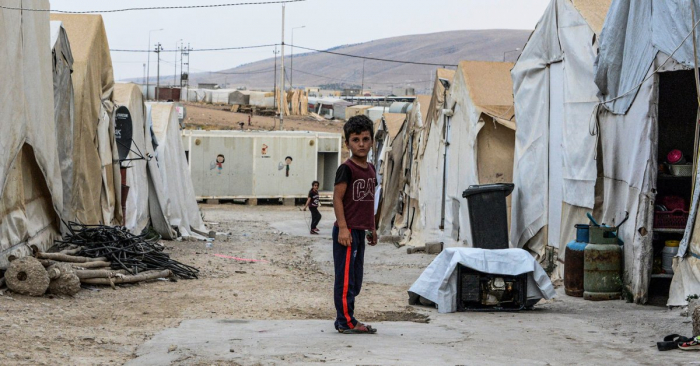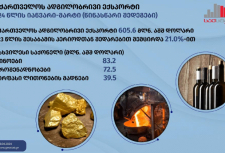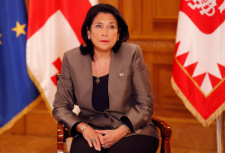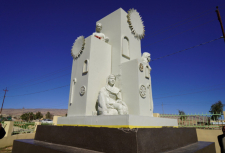Yazidis still displaced in their own country

Baghdad: A wide gravel road extends into the distance and blurs into the horizon. To the left is a sea of corrugated metal containers and electric poles — beyond that, nothing. This is where the Mam Rashan camp ends. The refugee camp in the Nineveh district of the autonomous Kurdistan region is like a small town. Over 1,500 Yazidi families live here. Jan Jessen, a German journalist, and development aid worker is a regular visitor to the area in northern Iraq.
Today, he’s meeting up with Mezafar Berges Matto, a friendly Yazidi man in his late 30s who seems much older. He and his family were just able to escape “Islamic State” (IS) terrorists and have been living in Mam Rashan since December 2015. They sit in their living room, a small 10-square-meter area about the size of a car parking space with a walnut-colored PVC floor and an unpleasant blue light filtered through cigarette smoke. As a group of wide-eyed children turn up — some belonging to Berges Matto, some from nearby homes — his wife serves tea and water.
When Jessen asks Berges Matto to recount his story, the man clasps his hands together, breathes deeply and nods. Silence falls over the room as he recounts how his family were living in a village in Sinjar when IS militants turned up. “They came and captured us. They wanted to force us to change religion,” he explains, saying it was a miracle that he and his family were able to escape into the mountains. They were lucky. According to the US-based NGO Yazda, some 12,000 people were kidnapped or killed in the first week of what the UN has characterized as the Yazidi genocide in August 2014.
Thousands were forced to flee, and many died as a result. ISIS fighters killed older people, along with those who were too weak to flee and those who refused to convert to Islam. They kidnapped and indoctrinated children. Boys were trained to become IS fighters, and women and girls were sold into sexual slavery. Thousands of Yazidis are still missing. Many mass graves have been found, but not all of them have been exhumed. But the “Islamic State” was driven out in 2017, so why have some 300,000 displaced Yazidis still not been able to go home? To find out, DW travelled west to Sinjar, a predominantly Yazidi region before the IS invasion. “There are different problems in different regions,” explains Thomas Schmidinger, a political scientist and cultural anthropologist who conducts research on ethnic and religious minorities in the Middle East.
The situation is particularly tense in Sinjar, which is crowded with various militias belonging to different factions: the People’s Protection Units (YPG), which is affiliated with the Kurdistan Workers Party (PKK), recognized by the US and the EU as a terrorist organization; the Popular Mobilisation Forces, supported in part by Iran; the peshmerga, the Kurdish branch of the Iraqi forces; and numerous other representatives of the Iraqi army. At the same time, Turkey regularly bombs the area, which is home to Kurdish insurgent groups who have demanded separation from Turkey.
The volatile security situation is the main reason not all Yazidis want to come back. And for many survivors, it’s simply unthinkable to come back to a place inhabited by their tormentors. “Quite a few supporters and even active IS fighters [were] living in the Arab villages and towns near the Yazidi settlements, and some of them still live there,” says Schmidinger. “The people coming back do not have jobs. The infrastructure is broken, and the security situation is difficult. But most of all they do not have jobs,” said Jessen.
This article was provided by Deutsche Welle
Tags: #yazidisinfo #newsyazidi #aboutyazidi #iraqyazidis
Yazidis still displaced in their own country

Baghdad: A wide gravel road extends into the distance and blurs into the horizon. To the left is a sea of corrugated metal containers and electric poles — beyond that, nothing. This is where the Mam Rashan camp ends. The refugee camp in the Nineveh district of the autonomous Kurdistan region is like a small town. Over 1,500 Yazidi families live here. Jan Jessen, a German journalist, and development aid worker is a regular visitor to the area in northern Iraq.
Today, he’s meeting up with Mezafar Berges Matto, a friendly Yazidi man in his late 30s who seems much older. He and his family were just able to escape “Islamic State” (IS) terrorists and have been living in Mam Rashan since December 2015. They sit in their living room, a small 10-square-meter area about the size of a car parking space with a walnut-colored PVC floor and an unpleasant blue light filtered through cigarette smoke. As a group of wide-eyed children turn up — some belonging to Berges Matto, some from nearby homes — his wife serves tea and water.
When Jessen asks Berges Matto to recount his story, the man clasps his hands together, breathes deeply and nods. Silence falls over the room as he recounts how his family were living in a village in Sinjar when IS militants turned up. “They came and captured us. They wanted to force us to change religion,” he explains, saying it was a miracle that he and his family were able to escape into the mountains. They were lucky. According to the US-based NGO Yazda, some 12,000 people were kidnapped or killed in the first week of what the UN has characterized as the Yazidi genocide in August 2014.
Thousands were forced to flee, and many died as a result. ISIS fighters killed older people, along with those who were too weak to flee and those who refused to convert to Islam. They kidnapped and indoctrinated children. Boys were trained to become IS fighters, and women and girls were sold into sexual slavery. Thousands of Yazidis are still missing. Many mass graves have been found, but not all of them have been exhumed. But the “Islamic State” was driven out in 2017, so why have some 300,000 displaced Yazidis still not been able to go home? To find out, DW travelled west to Sinjar, a predominantly Yazidi region before the IS invasion. “There are different problems in different regions,” explains Thomas Schmidinger, a political scientist and cultural anthropologist who conducts research on ethnic and religious minorities in the Middle East.
The situation is particularly tense in Sinjar, which is crowded with various militias belonging to different factions: the People’s Protection Units (YPG), which is affiliated with the Kurdistan Workers Party (PKK), recognized by the US and the EU as a terrorist organization; the Popular Mobilisation Forces, supported in part by Iran; the peshmerga, the Kurdish branch of the Iraqi forces; and numerous other representatives of the Iraqi army. At the same time, Turkey regularly bombs the area, which is home to Kurdish insurgent groups who have demanded separation from Turkey.
The volatile security situation is the main reason not all Yazidis want to come back. And for many survivors, it’s simply unthinkable to come back to a place inhabited by their tormentors. “Quite a few supporters and even active IS fighters [were] living in the Arab villages and towns near the Yazidi settlements, and some of them still live there,” says Schmidinger. “The people coming back do not have jobs. The infrastructure is broken, and the security situation is difficult. But most of all they do not have jobs,” said Jessen.
This article was provided by Deutsche Welle
Tags: #yazidisinfo #newsyazidi #aboutyazidi #iraqyazidis

























